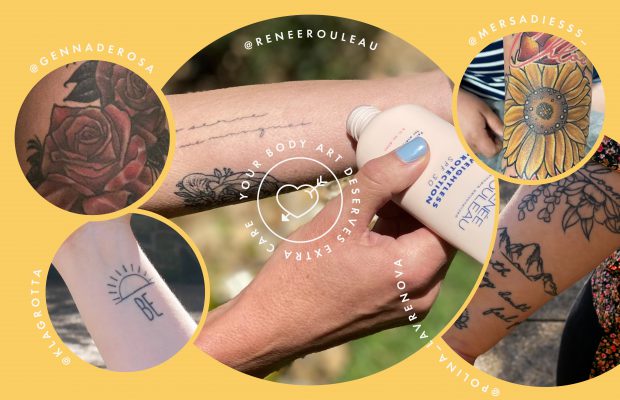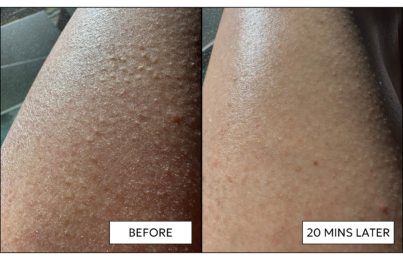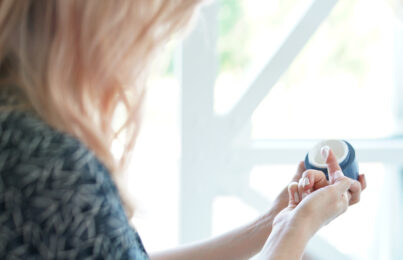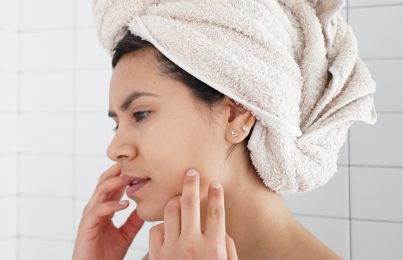It’s crazy to think that, not too long ago, tattoos were considered taboo. I remember getting my first tattoo when I was just twenty-two years old and still living in Boston. Tattoos were illegal in Boston at the time (imagine that), so my best friend and I drove to a tattoo shop in Rhode Island. When we got there, we flipped a coin to see who would go first, and it ended up being me. By the time the artist was finished with my tattoo, he said the shop was closing and my friend would have to come back tomorrow to get hers…but she never did! Twenty-five years later (a year and a half ago), we decided it was time to settle up and finally got tattoos together—her first, my third.
While tattoos may have been controversial back then, it’s almost harder to find someone who doesn’t have some kind of ink on their body these days. Keep reading for tips on how to take care of your skin after getting a tattoo, how to make your tattoo last longer, and how to care for your skin while getting a tattoo removed.
How to Take Care of Your Skin After Getting a Tattoo
In the weeks after getting a tattoo, you want to focus on healing the skin and preventing infection. Tattoo aftercare is fairly straightforward, but it’s important to be diligent about it to prevent any issues. Here’s what to keep in mind when taking care of your skin after getting a tattoo.
Protect It From the Sun—But Not With Sunscreen
Freshly tattooed skin is really raw and vulnerable, and that includes being vulnerable to UV damage from the sun. It’s important to keep your tattoo covered with opaque, loose-fitting clothing while it’s still healing. According to tattoo artist Daniel Stone (aka Winter Stone), it takes anywhere from four days to two weeks for a tattoo to heal depending on the size and location.
You should not put sunscreen on a new tattoo while it’s still healing. Since the skin is technically wounded, this could cause a lot of irritation and inflammation.
Keep It Clean and Hydrated
For the first three days after getting a new tattoo, Daniel recommends keeping it covered with Tegaderm. This is a waterproof dressing that will keep your skin dry and clean.
By the fourth day, you can remove the dressing but should continue to keep your new tattoo clean by washing it once or twice a day with something gentle and free of fragrance, synthetic dyes, SLS, or drying alcohols.
Any time you wash your tattoo, be sure to follow with something moisturizing to keep the skin healthy and let it heal. Daniel recommends using an occlusive balm, like Doctor Rogers RESTORE on your tattoo. Petroleum-based ointments like Aquaphor, he says, can actually lighten tattoo ink. Instead, he prefers a lanolin base with additional healing ingredients like vitamin E. Vitamin E (also known as tocopheryl linoleate) is an ingredient I love using in my own line of products thanks to its abilities to protect the skin from free radical damage (like UV rays), soothe irritation, and bind hydration to the skin.
Soothe Itchy Tattoos to Avoid Scratching
After the first week or so, you’ll likely start to notice some scabs and flaking as well as itching. This is normal, and it’s important not to pick or scratch at the skin since this can lead to permanent scarring. Continuing to keep your tattoo hydrated is essential at this point since it will help minimize itchiness and therefore the urge to scratch. You can keep using the RESTORE balm or a product like Bio Calm Repair Masque. This product includes oat kernel extract, bisabolol, and chamomile extract, all of which are powerful, plant-based anti-irritants.
If you’re still noticing redness or swelling at this stage, this could indicate an infection and you should speak to your doctor.
Long-Term Care to Make Your Tattoo Last Longer and Keep It Looking Fresh
Once your tattoo is fully healed, you can switch over to maintenance mode and focus on keeping up the appearance of your ink. Here’s what you can do to make your tattoos last longer.
Sun Protection, Sun Protection, Sun Protection
DNA damage from the sun’s rays is the number one cause of premature skin aging. These same rays will be responsible for fading your tattoos and making them look dull if you don’t protect them. Make a habit of applying sunscreen to your tattoos every day, just like you do your face and neck. This is by far the best thing you can do to protect your body art and keep it looking fresh. (Think you don’t need to wear sunscreen indoors? Think again.)
Keep Your Tattoos Moisturized
Simple, but oh so important! If you like using a balm like you did while your tattoo was healing, you can continue to do so. You can also use a simple, everyday moisturizer or lotion as long as it doesn’t include any harsh ingredients like fragrance or drying alcohols.
Exfoliate Weekly
When people ask how to keep their skin looking bright and glowy, I tell them to exfoliate. Why? Exfoliants like acids, enzymes, and scrubs work to remove expired cells from the surface of your skin. Since these expired cells are dry, they don’t reflect light. This can make your skin appear dull, so sloughing them off is a surefire way to brighten up your complexion.
The same principle applies to your tattoos. As dead, dry skin cells accumulate on top of them, they can start to appear dull. I recommend exfoliating the area once a week with an acid serum like Smoothing Body Serum. That’s what I use on my own tattoos.
Skincare and Tattoo Removal
In theory, tattoos are forever. In reality, you have options. According to Daniel, the only options for removing a tattoo you’re unhappy with are either a) a cover-up tattoo (which he says should be done by a very good cover-up artist) or b) laser tattoo removal.
How Does Tattoo Removal Work?
If you decide to go the route of laser tattoo removal, there are a few things you should know. Tattoos are removed using what’s called a Q-switch laser, which creates pulses of light energy. These pulses heat up the ink particles in your skin until they shatter and are eventually flushed away by your body’s immune system.
How Can I Take Care of My Skin During Tattoo Removal?
Even though laser tattoo removal is designed to work synergistically with your immune system’s amazing capabilities, it’s a lot to put your skin through. For that reason, you’ll want to be extra attentive to the areas being affected and take good care of them. Here’s what you can do:
- Wear sunscreen every day. Be sure to re-apply often if spending time outdoors and do your best to keep the area covered instead of exposed.
- Use antibiotic ointment. In the days immediately following your appointment, you should use a healing ointment and keep the area bandaged up to protect it.
- Keep it clean and moisturized. After the first few days, you can remove your bandage, but keep the area clean and moisturized just like you would a new tattoo (vitamin E can be helpful here, too).
- Do NOT pick at the skin. Resist the urge to pop any blisters or pick scabs, let your body resolve these on its own time.
- Don’t shave over the affected area. This could accidentally open the wound.
Daniel notes that tattoo removal can take a long time and is an expensive (not to mention painful) process, so choose your tattoos wisely.
I now have nine tattoos and while my first was spontaneous, I’ve put a lot of thought into the rest. When I get a tattoo, it’s something that captures an inspiring, meaningful moment of my life that I want to remember forever. For instance, one of my tattoos says “tu me manques,” which means “I miss you” in french. I got this as a tribute to Florian, my late husband.
Since I don’t want to just get a new tattoo on a whim, I follow a lot of artists on Instagram whose work I like. This helps inspire me so I know what I like when the time comes. A few favorites are Winter Stone, Jon Boy, and Connor Thomas.
Tattoos are such a fun way to express yourself and help you remember the important things in life. I hope you found this post helpful and that these tips help you preserve your body art for many years to come!
Celebrity Esthetician & Skincare Expert
As an esthetician trained in cosmetic chemistry, Renée Rouleau has spent 35 years researching skin, educating her audience, and building an award-winning line of products. Her hands-on experience as an esthetician and trusted skin care expert has created a real-world solution — products that are formulated for nine different types of skin so your face will get exactly what it needs to look and feel its best. Trusted by celebrities, editors, bloggers, and skincare obsessives around the globe, her vast real-world knowledge and constant research are why Marie Claire calls her “the most passionate skin practitioner we know.”




Comments:
Impressive content! This is a valuable resource for Tattoo. Thanks for sharing!
Posted By: Rechird |